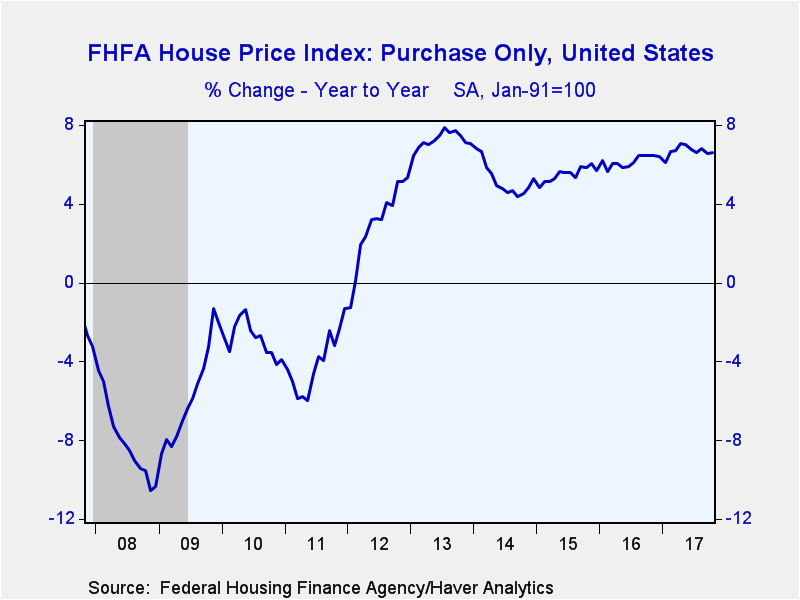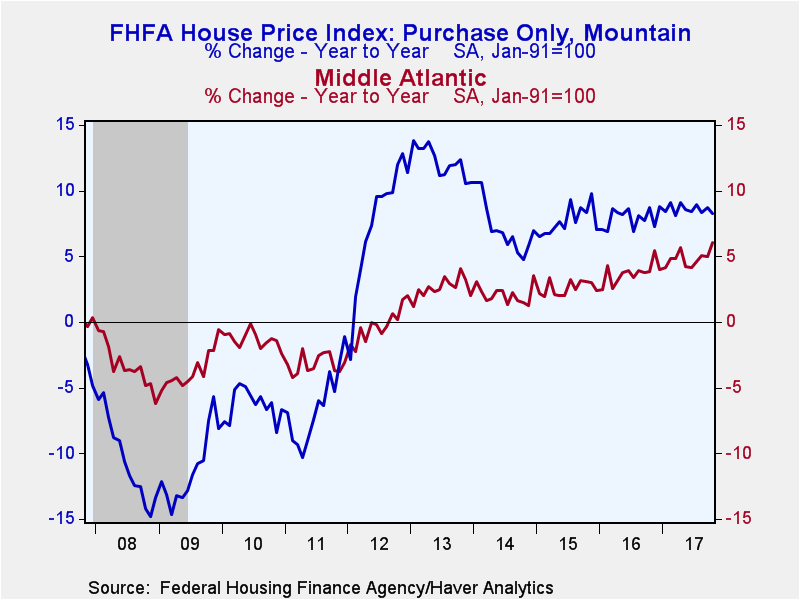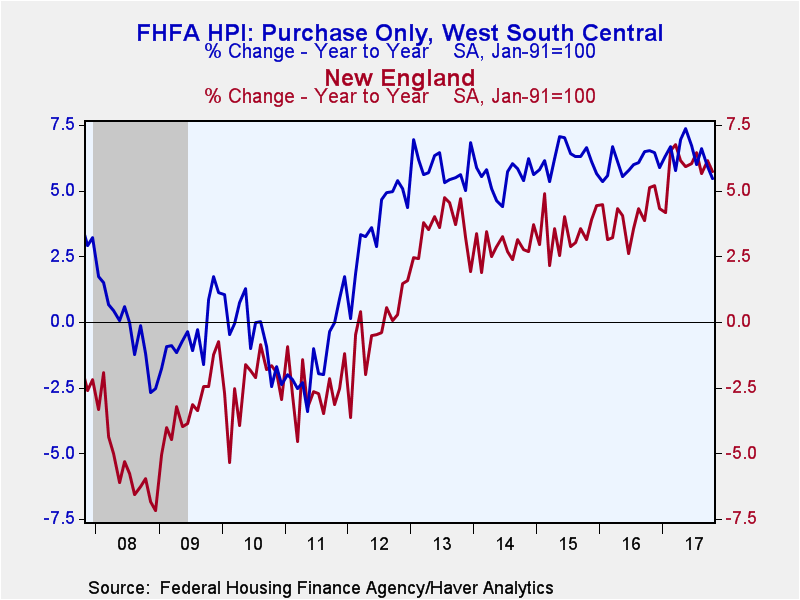 Global| Dec 21 2017
Global| Dec 21 2017U.S. FHFA House Price Treads Water in October
by:Sandy Batten
|in:Economy in Brief
Summary
The Federal Housing Finance Agency's (FHFA) index of U.S. house prices rose 6.6% y/y in October, up only slightly from a 6.5% y/y increase in September. While this reading is down from the recent peak of 7.1% in April, the annual pace [...]
The Federal Housing Finance Agency's (FHFA) index of U.S. house prices rose 6.6% y/y in October, up only slightly from a 6.5% y/y increase in September. While this reading is down from the recent peak of 7.1% in April, the annual pace of house price appreciation has been relatively stable throughout 2017, fluctuating between 6.5% and 7.1%. In the month of October, prices rose 0.5% m/m, the same increase as in September and slightly above the consensus market expectation. Over the past three months, prices have increased at a 7.4% annual rate.
The annual performance of home prices continued to vary significantly across the country. On the strong side were the Pacific, Mountain and East South Central regions where prices rose 8.7% y/y, 8.2% y/y and 8.2% y/y, respectively.
These relatively strong y/y gains were followed by the South Atlantic, East North Central and Middle Atlantic regions where prices increased roughly 6.0% y/y.
Somewhat slower annual house price appreciation occurred in the New England, West South Central and West North Central regions.
The FHFA house price index is a weighted purchase-only index that measures average price changes in repeat sales of the same property. An associated quarterly index also includes refinancings on the same kinds of properties. The indexes are based on transactions involving conforming, conventional mortgages purchased or securitized by Fannie Mae or Freddie Mac. Only mortgage transactions on single-family properties are included. The FHFA data are available in Haver's USECON database.
| FHFA U.S. House Price Index, Purchase Only (SA %) |
Oct | Sep | Aug | Oct Y/Y | 2016 | 2015 | 2014 |
|---|---|---|---|---|---|---|---|
| Total | 0.5 | 0.5 | 0.8 | 6.6 | 6.2 | 5.6 | 5.3 |
| Pacific | 0.0 | 0.8 | 1.5 | 8.7 | 8.1 | 7.9 | 9.3 |
| Mountain | 0.8 | 1.1 | 0.2 | 8.2 | 8.0 | 7.8 | 7.1 |
| East South Central | 2.8 | -0.6 | 0.4 | 8.2 | 5.2 | 4.8 | 3.3 |
| South Atlantic | 0.1 | 0.4 | 0.8 | 6.2 | 7.2 | 6.3 | 5.6 |
| East North Central | 0.6 | 0.7 | 0.4 | 6.1 | 5.4 | 4.5 | 4.4 |
| Middle Atlantic | 1.2 | 0.3 | 0.8 | 6.0 | 3.8 | 2.6 | 2.1 |
| New England | 0.7 | 0.5 | 0.3 | 5.7 | 4.1 | 3.5 | 2.9 |
| West South Central | 0.1 | 0.1 | 1.2 | 5.5 | 6.1 | 6.3 | 5.5 |
| West North Central | -0.4 | 0.7 | 0.5 | 4.8 | 5.7 | 4.1 | 4.0 |
|
Mountain: Montana, Idaho, Wyoming, Nevada, Utah,
Colorado, Arizona and New Mexico. |
Sandy Batten
AuthorMore in Author Profile »Sandy Batten has more than 30 years of experience analyzing industrial economies and financial markets and a wide range of experience across the financial services sector, government, and academia. Before joining Haver Analytics, Sandy was a Vice President and Senior Economist at Citibank; Senior Credit Market Analyst at CDC Investment Management, Managing Director at Bear Stearns, and Executive Director at JPMorgan. In 2008, Sandy was named the most accurate US forecaster by the National Association for Business Economics. He is a member of the New York Forecasters Club, NABE, and the American Economic Association. Prior to his time in the financial services sector, Sandy was a Research Officer at the Federal Reserve Bank of St. Louis, Senior Staff Economist on the President’s Council of Economic Advisors, Deputy Assistant Secretary for Economic Policy at the US Treasury, and Economist at the International Monetary Fund. Sandy has taught economics at St. Louis University, Denison University, and Muskingun College. He has published numerous peer-reviewed articles in a wide range of academic publications. He has a B.A. in economics from the University of Richmond and a M.A. and Ph.D. in economics from The Ohio State University.










